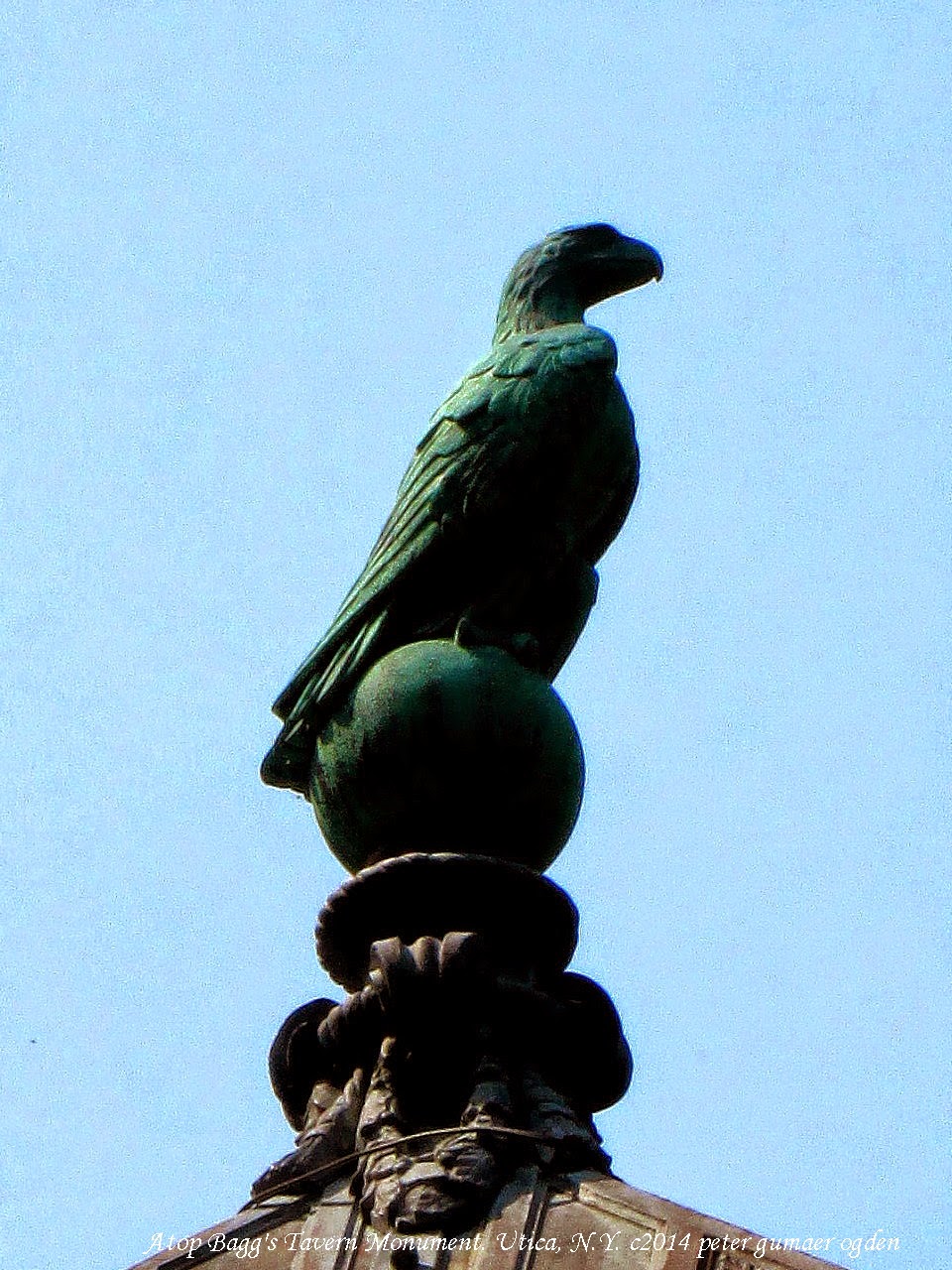Authentic original cast stone streamlined Art Moderne bench at the Utica Aud circa 1950. Echoes of the dramatic design of the TWA terminal at New York's Kennedy Airport.w
Seward Ogden , Seward J. Ogden , Seward Jackson Ogden , Ward Ogden Elizabeth Webb Ogden Zizi Ogdenard J
Seward Ogden , Seward J. Ogden , Seward Jackson Ogden , Ward Ogden Elizabeth Webb Ogden Zizi Ogdenard J
Anonymous Troll and Dog snow sculpture that I came upon in the winter of 2012-2013 in back of the Law Library downtown.
High Victorian painted porch "gingerbread" wood turnings from a large Italianate mansion at Steuben Park.
Hotel Utica Window circa 1914. Downtown.
Cast Iron Decorative Victorian Eyebrow Window Grate. From a circa 1855 Italianate brick house at 521 Columbia Street at Fay Street, west Utica. Demolished in 2013 for the new arterial greenway. The demolition company, fortunately, appeared to be involved also in architectural salvage. Window grates of this vintage have become almost rare in Utica.
Interior of vintage locksmith's shop. Bagg's Square West, 2013.
Window with cast iron Greek key motif in one of the few remaining Greek Revival commercial buildings in Utica; at 98 Genesee Street; Bagg's Square West. This building is famous in local abolitionist history as the setting for the brief imprisonment of a "runaway" slave who was freed by an abolitionist "mob" who stormed the building.
High Victorian dormer window with Palladian influence, Ionic columns and rising or setting sun fan light at one of Rutger Street's better preserved "mansions": 408 Rutger Street. "Downtown".
Victorian window with Rococo Revival cast iron lintel circa 1860 in one of Utica's Victorian " mansions", 320 Rutger Street.
Richardsonian Romanesque dormer window at No.5 Rutger Park. This stone mansion with rusticated masonry was designed by Utica architect Jacob Agne and built in 1889 when it became the home of Thomas A. Kinney who was mayor of Utica in 1885 and 1897. Note the original fish scale slate roof.
Gothic Revival Mid 19th Century Church, semi-abandoned at 930 Bleecker Street, east Utica. Circa 2011.
Hotel Utica Window circa 1914. Downtown.
Cast Iron Decorative Victorian Eyebrow Window Grate. From a circa 1855 Italianate brick house at 521 Columbia Street at Fay Street, west Utica. Demolished in 2013 for the new arterial greenway. The demolition company, fortunately, appeared to be involved also in architectural salvage. Window grates of this vintage have become almost rare in Utica.
Interior of vintage locksmith's shop. Bagg's Square West, 2013.
Turned and Painted Wood Victorian Pilaster Pendulum. circa 1855-1865. A wonderful wood turner's whimsey. I have never before seen one of these and there are several of these on this building at the east end of Plant Street. It is amazing that such fragile and delicate decorations have survived out of doors for over 150 years of weather, storms and brutal building remodelings throughout the city. The owner of this apartment row must have a unique and wonderful respect for historic architecture and is to be commended.
Palladian Window with what appear to be cast [ possibly plaster ] floral bowers. Circa 1885. 1 Hopper Street, downtown.
Classical Revival window with broken pediment on 19th century Savings Bank of Utica. Corner Genesee Street and Bank Street, downtown.
Classical Revival window with broken pediment on 19th century Savings Bank of Utica. Corner Genesee Street and Bank Street, downtown.
Window with cast iron Greek key motif in one of the few remaining Greek Revival commercial buildings in Utica; at 98 Genesee Street; Bagg's Square West. This building is famous in local abolitionist history as the setting for the brief imprisonment of a "runaway" slave who was freed by an abolitionist "mob" who stormed the building.
High Victorian dormer window with Palladian influence, Ionic columns and rising or setting sun fan light at one of Rutger Street's better preserved "mansions": 408 Rutger Street. "Downtown".
Victorian window with Rococo Revival cast iron lintel circa 1860 in one of Utica's Victorian " mansions", 320 Rutger Street.
Richardsonian Romanesque dormer window at No.5 Rutger Park. This stone mansion with rusticated masonry was designed by Utica architect Jacob Agne and built in 1889 when it became the home of Thomas A. Kinney who was mayor of Utica in 1885 and 1897. Note the original fish scale slate roof.
Gothic Revival Mid 19th Century Church, semi-abandoned at 930 Bleecker Street, east Utica. Circa 2011.
Hand cut exterior wood fretwork "gingerbread" panel decoration circa 1860 at 511 Henry Street.
METALWORK
Below: Very large circa 1925 Moorish style hand made steel or iron lamp in the entry way of 259 Genesee Street. Downtown. Below: The same lamp as a Buddhist themed poster available for purchase from:
peter-gumaer-ogden.fineartamerica.com
Antique bronze bird of prey finial atop the Bagg's Tavern Monument. Downtown.
VEHICLES
Vintage Utica Police Patrol Car # 100. Oriskany Boulevard, downtown.
METALWORK
Large copper dragon weather vane atop Munson Williams Proctor Arts Institute.
Below: Very large circa 1925 Moorish style hand made steel or iron lamp in the entry way of 259 Genesee Street. Downtown. Below: The same lamp as a Buddhist themed poster available for purchase from:
peter-gumaer-ogden.fineartamerica.com
Antique bronze bird of prey finial atop the Bagg's Tavern Monument. Downtown.
VEHICLES
Vintage Utica Police Patrol Car # 100. Oriskany Boulevard, downtown.




























































